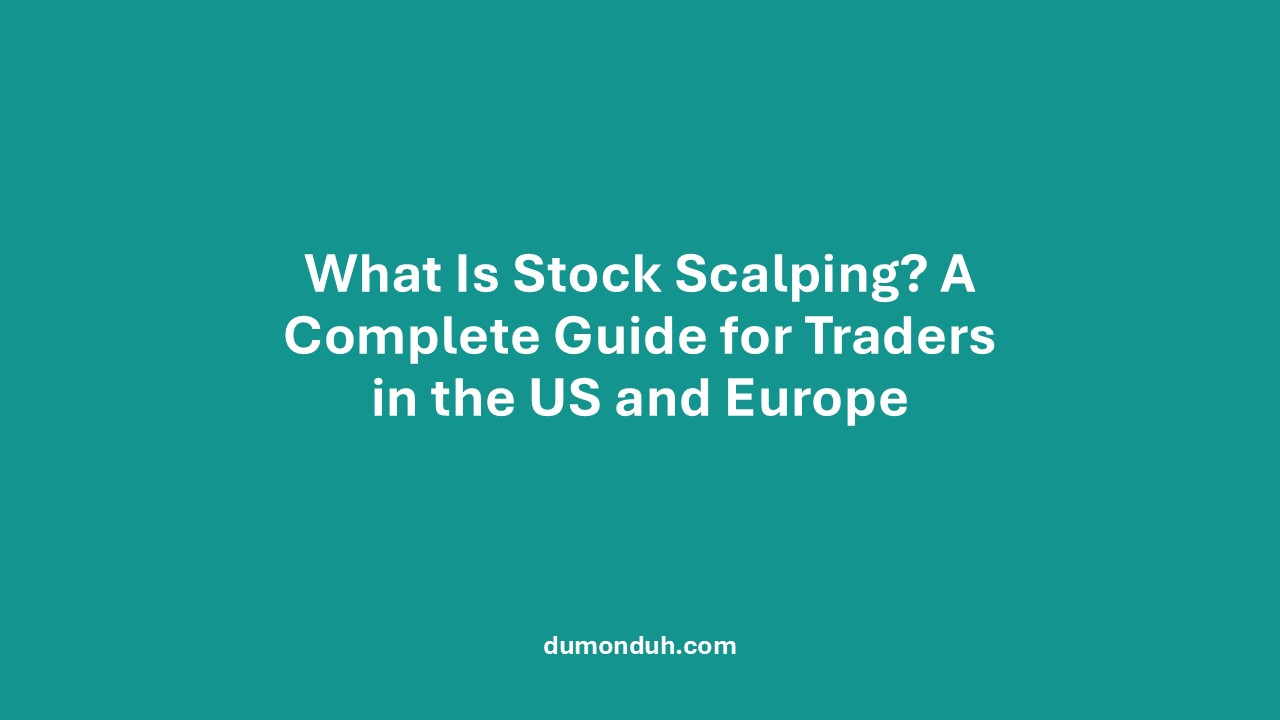Stock scalping is a fast-paced trading strategy that has gained popularity among active traders in both the United States and Europe. While long-term investors focus on fundamentals and multi-year growth, scalpers aim to capture small, frequent profits by entering and exiting trades within seconds or minutes.
This approach requires discipline, precision, and a deep understanding of market mechanics. Below is a clear and comprehensive overview of how stock scalping works, its advantages, risks, and the tools traders typically use.
What Is Stock Scalping?
Stock scalping is an ultra-short-term trading strategy where traders buy and sell stocks rapidly to profit from tiny price movements. A typical scalper may place dozens or even hundreds of trades per day, often holding each position for less than a minute.
The goal is simple:
Take many small gains that accumulate into meaningful profit over time.
Unlike day trading or swing trading, scalping relies on:
-
Very tight bid-ask spreads
-
High liquidity
-
Rapid execution
-
Price movements of a few cents
Why Scalping Is Popular in the US and Europe
Both regions have highly developed financial markets with:
-
Deep liquidity (especially in large-cap stocks)
-
Advanced electronic trading systems
-
Strict but clear regulatory frameworks
-
Access to low-latency trading platforms
This makes the environment ideal for strategies that depend on fast execution.
In the US, scalping is especially common in:
-
NASDAQ and NYSE stocks
-
ETFs such as SPY, QQQ, and IWM
In Europe, scalping is widely used in:
-
DAX (Germany)
-
FTSE 100 (UK)
-
CAC 40 (France)
-
Euro Stoxx 50
How Scalping Works
A scalper typically follows this workflow:
-
Identify a high-liquidity stock
Stocks with tight spreads (e.g., Apple, Tesla, Microsoft) are preferred. -
Monitor price levels and order flow
Many scalpers rely on Level II data and time-and-sales to see market depth. -
Enter a trade at the moment of a micro-trend
Often supported by technical indicators such as moving averages or VWAP. -
Exit quickly when profit targets are met
Targets may be as small as 0.05% to 0.2% of price movement. -
Repeat multiple times throughout the session
Consistency is more important than large wins.
Common Strategies Used in Scalping
1. Breakout Scalping
Entering trades when price breaks above resistance or below support.
2. VWAP (Volume Weighted Average Price) Scalping
Buying near VWAP in an uptrend and selling near VWAP in a downtrend.
3. Market-Making Scalping
Placing buy and sell limit orders inside the spread to capture the difference.
4. Momentum Scalping
Following sharp, high-volume price movements for quick gains.
Tools Scalpers Commonly Use
Successful scalping depends on speed and accuracy. Traders typically need:
-
Direct Market Access (DMA)
For fastest order execution. -
Level II Market Data
To visualize bid/ask depth. -
Low-latency trading platform
Such as DAS Trader, TradeStation, or MetaTrader with ECN accounts. -
Risk management software
To set auto-stops, position sizing, and maximum daily loss limits.
Advantages of Scalping
✔ Fast turnaround — traders rarely hold overnight risk
✔ Many opportunities each trading day
✔ Small losses can be corrected quickly
✔ Works well in both trending and ranging markets
Risks and Challenges
Despite its appeal, scalping is not suitable for everyone.
⚠ High stress due to fast decision-making
⚠ High transaction costs (fees, commissions, spreads)
⚠ Requires strong focus and emotional control
⚠ Not ideal during low-liquidity or high-volatility spikes
⚠ Some brokers restrict scalping or enforce order limits
US traders must also comply with the Pattern Day Trader (PDT) rule, requiring a minimum $25,000 account balance for frequent trades.
Is Scalping Legal?
Yes — scalping is legal in both the US and Europe. However:
-
Some brokers prohibit or limit scalping.
-
Exchanges monitor for manipulation (e.g., spoofing).
-
Traders must follow local regulations such as FINRA (US) and ESMA (EU).
As long as trades are executed honestly and within rules, scalping is fully permitted.
Related: Best Stock Scalping Platforms for U.S. and European Traders (Full Guide)
Who Is Scalping Best For?
Scalping is most suitable for traders who are:
-
Comfortable making fast decisions
-
Able to stay focused for long periods
-
Equipped with a fast internet and DMA platform
-
Experienced with technical analysis
-
Capable of managing risk strictly
It is not recommended for beginners or for traders who prefer slower, long-term strategies.

